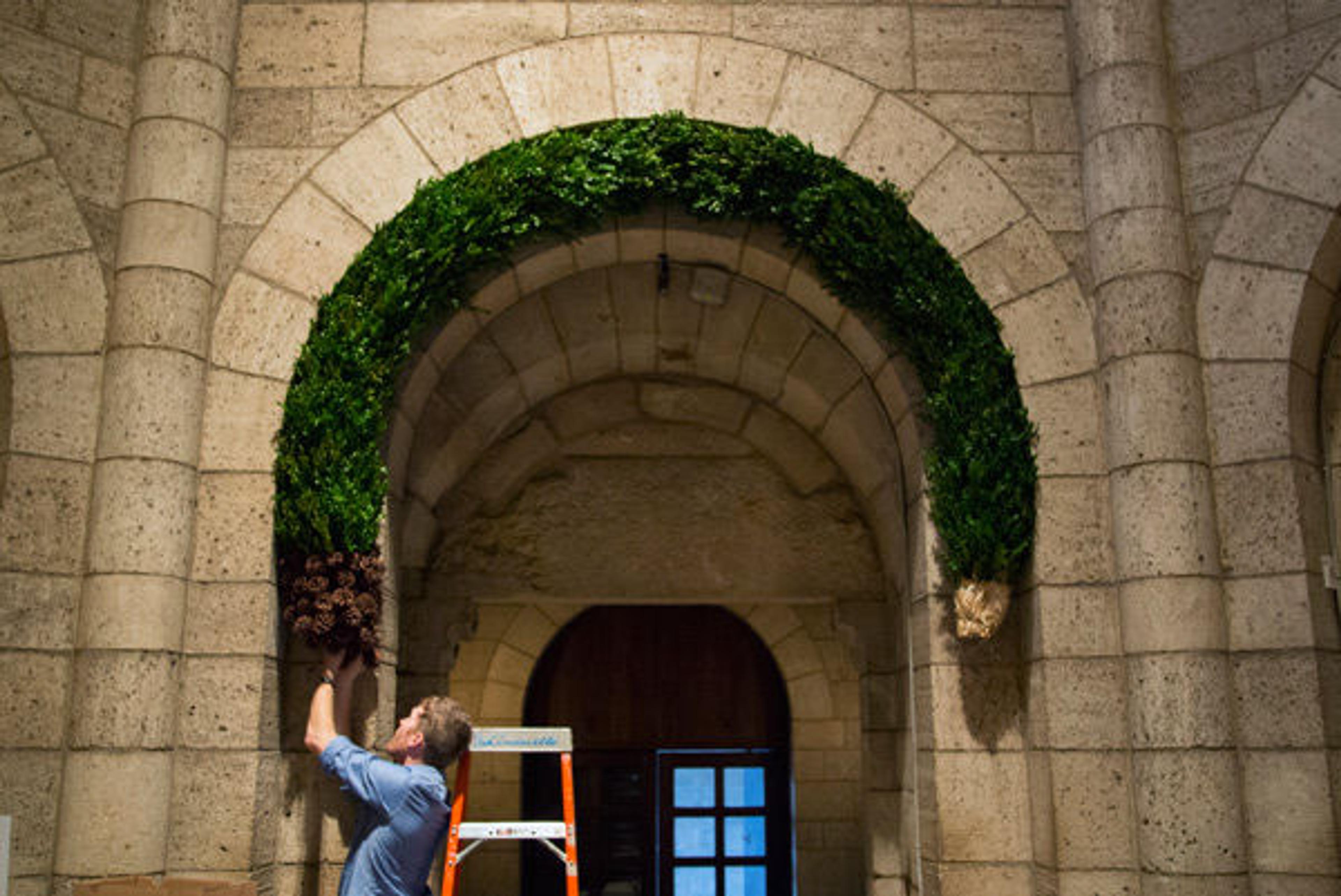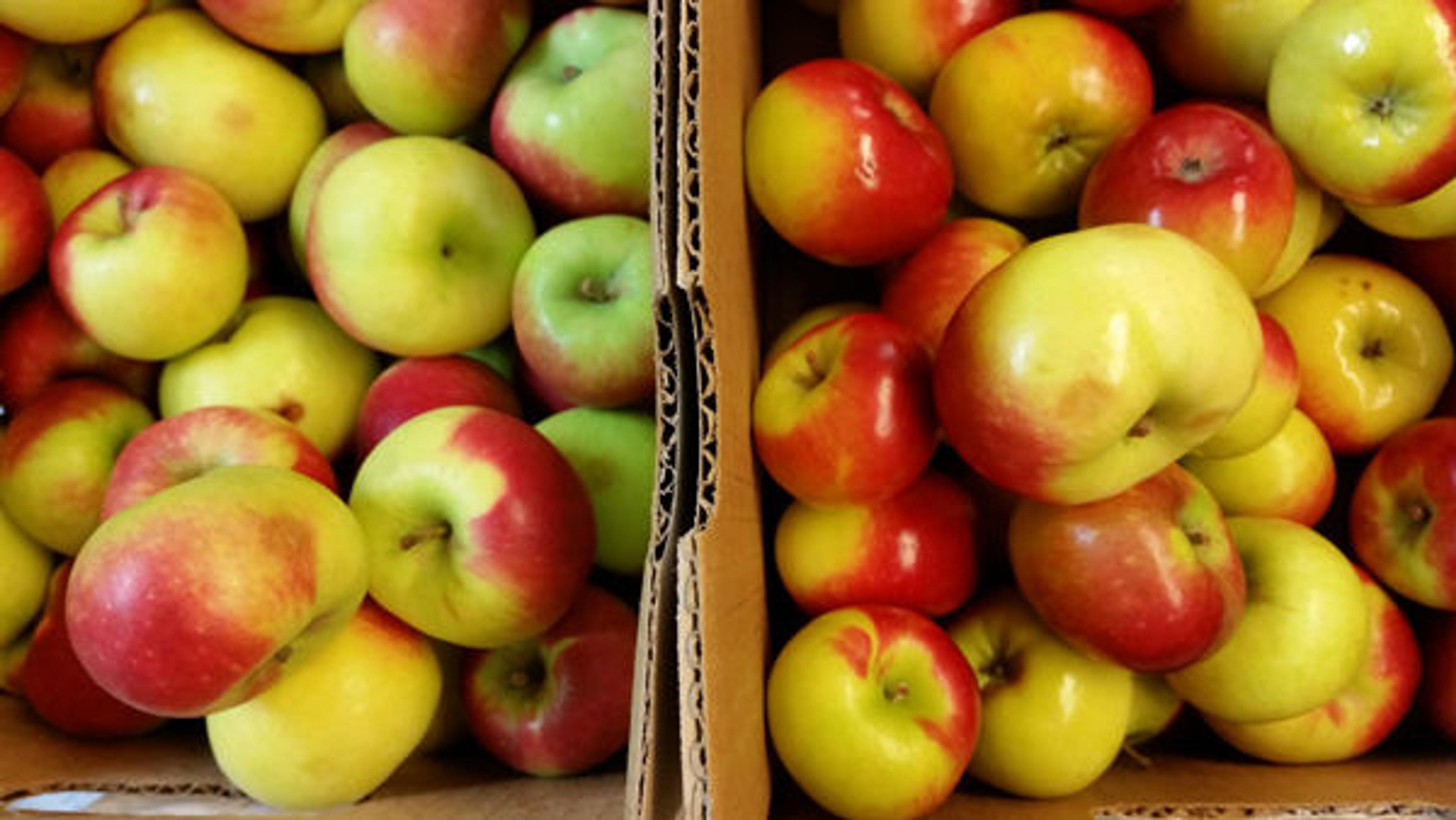
Caleb adds pinecone corbels at the base of each arch. The Main Hall arches are on view in this partially finished state for the day, and the fruit and nuts are added in the evening.
«The Cloisters museum and gardens will be decorated for the holidays through January 6. Today's post is intended to provide historical context for the designs, explain how the decorations are made, and to entice readers to visit and see them in person.»
The unique decorations are all made using fresh plant materials associated with the medieval celebration of Christmastide, the twelve days between the Nativity and the Epiphany. Visual evidence for medieval decorations is extremely rare, but research into medieval carols, wassails, romances, and customs, some of which date to Antiquity, informed the designs on display throughout the galleries.
This time-lapse video condenses the work of six people over four hours, giving readers a behind-the-scenes look at the installation of just one of our decorations.
Evergreens have long symbolized eternal life and appear in the decorations in the form of holly, ivy, and boxwood. Holly represented light and life in the Middle Ages, its red berries symbolic of Christ's blood, and it contrasted with the black-fruited ivy, which stood for the darkness of winter and was also identified with the Virgin. Holly was an important apotropaic plant, bestowing blessings and protection, especially when placed over a doorway. It was the most significant plant for Christmastide, and English holly is used to decorate the arch visitors pass under at the Museum entrance. The area around the entrance is newly planted with holly trees and boxwood; older holly trees can be seen along the drives, in Trie Cloister garden, and elsewhere on the grounds.

Carly and Yvette cover the wood and straw arch forms with boxwood from North Carolina to provide a green base. Each arch takes one person about a day to make. Beautiful English holly from a family farm in Oregon is added to the arch at the Postern Gate before it is installed. The Main Hall arches are installed with the boxwood base before the Museum opens, and are decorated after we close.
Ivy is used in the Main Hall arches and is plentiful on the grounds as well. Both holly and ivy appear in Christmas carols that are still sung today. Apples and nuts were stored and eaten throughout the winter, were symbols of fertility, and appear in many representations of the Virgin and Child. The trees were wassailed in winter to encourage a bountiful crop the following year. Roses also appear in carols and in popular stories of plants that miraculously bloomed on Christmas Eve, far out of season. Lady apples, hazelnuts, and rosehips form bosses on the boxwood and ivy-covered arches in the Main Hall.

Large ivy leaves are gathered from the grounds. About two thousand leaves are collected, then individually washed and inserted into water-filled floral picks. Trays of ivy are held until the arches are decorated. The face of the Main Hall arches is covered in ivy during the decoration process.
Wheat's association with life is an ancient one; the early Church linked it to the symbolism of the Eucharist. A sheaf of wheat often appears in fourteenth- and fifteenth-century Nativity scenes, where it alludes to the sacramental aspect of Christ's birth. A wheat sheaf has been placed beside the thirteenth-century altar frontal in the Langon Chapel to reflect this iconography. Customs involving wheat included saving a sheaf from the harvest to create a special dish called "frumenty" to celebrate the new year. It was also served to sheep and cattle as a celebratory meal or scattered in the streets, in keeping with Saint Francis's wish to include the birds in the Christmas feast.
The candelabra in the Romanesque Hall, Langon Chapel, and Cuxa Cloister are draped with garlands and wreaths using many of the materials already mentioned, as well as white roses. Seasonal plants like cyclamen and hellebore are displayed in the Saint-Guilhem Cloister, and bouquets are located in several spots as well.

Bosses of lady apples, rosehips, and hazelnuts are inserted into the straw arch form. The apple picks are individually fabricated from metal pins that have to be wired onto wooden picks. Hazelnuts can be reused for several years, and last year many hours were devoted to creating new bundles of nuts. Twenty pounds of freshly harvested hazelnuts from a family farm in Oregon arrived, whereupon a hole was drilled into each one, a wire glued to the nut, the nuts gathered into bundles of five, and the bundles attached to wooden picks.
Preparation by the gardens staff begins in the fall. Many of the materials have been ordered from the same sources for years, and deliveries start arriving around Thanksgiving. Much of the work in producing the decorations takes place over the course of weeks and ranges from taking inventory of our supplies to early-morning shopping trips for flowers. Because we use fresh plant stuffs and try to balance the medieval tradition with modern expectations, the decorations can be displayed for only a limited amount of time. The lady apples on the arches, for example, must be replaced weekly.

Lady apples are delivered from a New York State orchard every week, and are each buffed before they are attached to the picks. Apples are used in the arches as well as in the smaller decorations throughout the galleries. We use about three hundred pounds in total.
The decorations are the work of many hands, including our garden volunteers and staff from other offices who cheerfully pitch in during breaks in the day. We hope many of our readers will be able to visit during the holidays to experience The Cloisters at this special time of year. For those who cannot be here in person, this post provides a glimpse into the making and meaning of our holiday display.